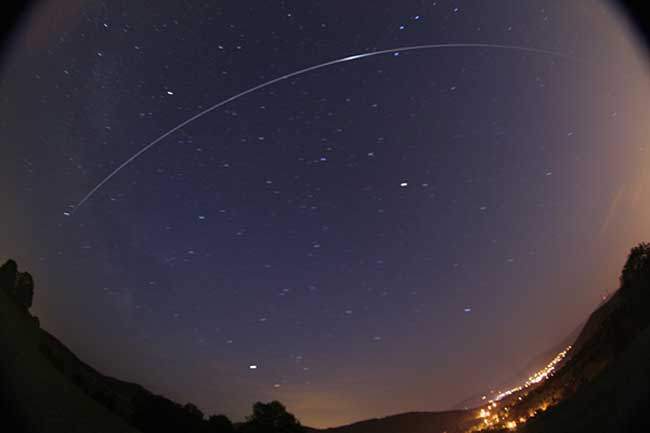How to See 2 Spaceships in the Night Sky Tonight

Skywatchers have one last chance to see two crewed spaceships sail across the night sky in 2011 tonight (Dec. 22) as a Russian spacecraft closes in on the International Space Station, NASA officials say.
The Russian-built Soyuz space capsule launched into orbit on Wednesday (Dec. 21) carrying three new crewmembers for the space station. This is the final manned spaceflight of 2011, so tonight is the last opportunity of the year to see multiple crewed spacecraft in action.
The Soyuz is ferrying NASA astronuat Don Pettit, Russian cosmonaut Oleg Kononenko and Dutch astronaut Andre Kuipers to the space station, where they will join three other crewmembers already aboard.
"Pettit, Kononenko and Kuipers are scheduled to dock to the Rassvet module of the station at [10:22 a.m. EST] Friday, Dec. 23," NASA officials wrote in an update to the agency's skywatching website. "Sightings of their Soyuz vehicle before docking may be possible over your area."
The International Space Station is the largest artificial structure in space. It is the size of a football field and can easily be seen from the ground, even without a telescope. The space station, which was completed earlier this year, appears as a bright moving star that can rival the planet Venus in brightness.
Russia's Soyuz spacecraft are much smaller than the space station, but can also appear as a moving light across the night sky. The Soyuz is chasing the space station, so both spacecraft can be seen in succession by skywatchers who have clear weather and know where — and when — to look.
There are several websites that provide tips for spotting the space station, Soyuz and other spacecraft in the night sky. They include:
Get the Space.com Newsletter
Breaking space news, the latest updates on rocket launches, skywatching events and more!
Each website will ask for your zip code or city, then provide a list of suggested spacecraft-spotting times. Predictions computed a few days ahead of time are usually accurate within a few minutes.
But be warned: These predictions can change due to the slow decay of the space station's orbit and periodic re-boosts to higher altitudes. So check frequently for updates.
Another great site is this one, which provides real-time satellite tracking. The website shows you where over the Earth the space station happens to be at any given moment during the day or night.
The two spacecraft aren't the only sky show to try and catch tonight. The annual Ursid meteor shower peaks tonight and could be better than average since the moon is in its dark "new" phase and won't interfere. Several planets of the solar system, including Venus, Jupiter and Mars, are also visible in the sky this week in an extra cosmic treat.
If you snap a photo of the Soyuz and space station flying in tandem and would like to share the image with SPACE.com, please contact Managing Editor Tariq Malik at: tmalik@space.com.
You can follow SPACE.com Managing Editor Tariq Malik on Twitter @tariqjmalik. Follow SPACE.com for the latest in space science and exploration news on Twitter @Spacedotcom and on Facebook.
Join our Space Forums to keep talking space on the latest missions, night sky and more! And if you have a news tip, correction or comment, let us know at: community@space.com.

Tariq is the Editor-in-Chief of Space.com and joined the team in 2001, first as an intern and staff writer, and later as an editor. He covers human spaceflight, exploration and space science, as well as skywatching and entertainment. He became Space.com's Managing Editor in 2009 and Editor-in-Chief in 2019. Before joining Space.com, Tariq was a staff reporter for The Los Angeles Times covering education and city beats in La Habra, Fullerton and Huntington Beach. In October 2022, Tariq received the Harry Kolcum Award for excellence in space reporting from the National Space Club Florida Committee. He is also an Eagle Scout (yes, he has the Space Exploration merit badge) and went to Space Camp four times as a kid and a fifth time as an adult. He has journalism degrees from the University of Southern California and New York University. You can find Tariq at Space.com and as the co-host to the This Week In Space podcast with space historian Rod Pyle on the TWiT network. To see his latest project, you can follow Tariq on Twitter @tariqjmalik.










